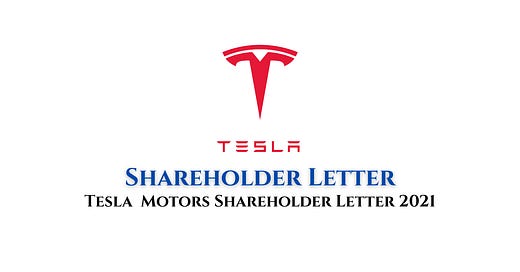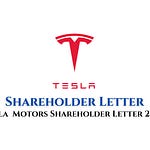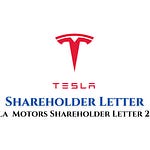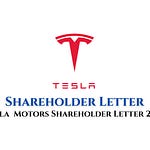Tesla Quarterly Performance Briefing (Q1 2021 - Q4 2021)
Sources: Tesla Motors – First Quarter 2021 Shareholder Letter
Tesla Motors, Inc. – Second Quarter 2021 Shareholder Letter
Tesla Motors, Inc.– Third Quarter 2021 Shareholder Letter
Tesla Motors, Inc.– Fourth Quarter & Full Year 2021 Shareholder Letter
Executive Summary
Tesla experienced significant growth and profitability throughout 2021, setting new records in vehicle production and deliveries, and achieving substantial increases in net income and operating margins. The company continued to expand its global manufacturing footprint and advance its technological capabilities in self-driving and battery development, despite facing ongoing supply chain challenges, particularly semiconductor shortages.
Key Themes
1. Robust Financial Performance and Profitability Growth
Tesla demonstrated strong financial health and increasing profitability across all quarters of 2021.
GAAP Net Income: Consistently grew, reaching an unprecedented $1.1B in Q2 2021, and further accelerating to $2.321B in Q4 2021, representing a 760% YoY increase from Q4 2020.
Non-GAAP Net Income: Showed similar robust growth, with Q4 2021 reaching $2.879B, a 219% YoY increase.
Operating Margin: Steadily improved throughout the year, from 5.7% in Q1 2021 to a remarkable 14.7% in Q4 2021, marking a 940 basis point (bp) YoY improvement. Tesla explicitly stated the expectation for operating margin to "continue to grow over time, continuing to reach industry-leading levels."
Automotive Gross Margin (GAAP): Rose from 26.5% in Q1 2021 to 30.6% in Q4 2021, an increase of 648 bp YoY. Notably, the automotive gross margin excluding regulatory credits (non-GAAP) also showed strong improvement, reaching 28.8% in Q3 2021. Regulatory credits decreased as a proportion of revenue, from $518M in Q1 2021 to $279M in Q3 2021, and $314M in Q4 2021.
Adjusted EBITDA: Demonstrated significant growth, reaching $4.090B in Q4 2021, a 121% YoY increase. The adjusted EBITDA margin also saw substantial improvement, from 17.7% in Q1 2021 to 23.1% in Q4 2021.
Cash Position: While cash and cash equivalents fluctuated, they remained substantial, ending Q4 2021 at $17.576B, despite significant capital expenditures. Tesla maintains "sufficient liquidity to fund our product roadmap, long-term capacity expansion plans and other expenses."
Free Cash Flow: Showed positive trends, with Q4 2021 recording $2.775B, and the trailing 12 months (TTM) free cash flow reaching $5.015B by the end of 2021. Capital expenditures increased significantly year-over-year, rising by 196% in Q1 2021 compared to Q1 2020, and by 105% for the full year 2021 compared to 2020, reaching $6.482B.
2. Record Production and Deliveries, Model 3/Y Dominance
Tesla consistently broke vehicle production and delivery records throughout 2021, driven primarily by the Model 3 and Model Y.
Total Deliveries: Surpassed 200,000 vehicles in Q2 2021, reaching 241,391 in Q3 2021, and culminating in 308,650 deliveries in Q4 2021. For the full year 2021, total deliveries reached 936,222 units, an 87% YoY increase.
Total Production: Followed a similar upward trend, reaching 305,840 units in Q4 2021. Total production for 2021 was 930,422 units, an 83% YoY increase.
Model 3/Y Focus: Production and deliveries of Model 3/Y consistently represented the vast majority of Tesla's output. Model 3/Y production saw a 169% YoY increase in Q2 2021 and a 79% increase for the full year 2021. Model S/X production and deliveries, in contrast, significantly decreased in Q1 and Q2 2021 due to model changeovers, but saw a strong recovery in Q3 and Q4.
Global Inventory: Days of supply for global vehicle inventory decreased significantly, from 11 days in Q4 2020 to 4 days in Q4 2021, indicating very high demand relative to supply.
Market Position: Tesla highlighted that "Our competitors are 98% ICE" (Internal Combustion Engine), and showed that Tesla Model 3 sales significantly outpaced premium competitors like BMW 3 Series, Mercedes E-Class, and Audi Q5/A6 in the US over the past two years. Tesla buyers primarily trade in non-premium brands like Toyota, Honda, and Ford.
3. Manufacturing Capacity Expansion
Tesla continued its aggressive global expansion of manufacturing capacity.
Gigafactories Berlin and Texas: Construction progressed significantly, with both factories remaining "on track to start production and deliveries from each location in 2021" for Model Y. By Q4 2021, both were in "Equipment test" phase. Photos throughout the reports illustrate the rapid construction progress of these large facilities, including paint shops, gigacasting, stamping presses, and general assembly lines.
Gigafactory Shanghai: Continued to expand, with installed annual capacity for Model 3/Y increasing to ">450,000 Production."
Future Products: Cybertruck and Tesla Semi were stated to be "In development," with Tesla Semi deliveries expected to begin in 2021 (Q1 report) and Cybertruck production planned for Austin subsequent to Model Y. Roadster and "Future Product" are also listed as "In development."
Volume Outlook: Tesla aims for "50% average annual growth in vehicle deliveries" over a multi-year horizon, acknowledging that growth depends on "equipment capacity, operational efficiency and the capacity and stability of the supply chain."
4. Advanced Technology Development
Tesla emphasized progress in its core technologies, particularly Full Self-Driving (FSD) and battery development.
Full Self Driving (FSD): The team focused on the "V9 version of FSD City Streets beta," which was expected to become "more widely available in the United States." The "successful launch of FSD subscription in July" (Q2 report) was a key highlight. Tesla expressed confidence in a "vision-only system" for full autonomy, with radar becoming "unnecessary earlier than expected."
Battery and Powertrain: Tesla reported successful validation of performance and lifetime for its 4680 cells produced at the Kato facility, with a focus on improving manufacturing processes to achieve volume production. Successful internal crash testing of the structural pack architecture with a single-piece front casting was also noted.
5. Growth in Energy Storage and Services Businesses
Beyond vehicles, Tesla's energy storage and services segments showed significant development.
Energy Storage: Deployments grew "71% YoY in Q1 2021" and "more than tripled YoY in Q2 2021," mainly driven by Powerwall and Megapack. Demand for Powerwall "continues to far exceed our production rate," leading to a shift in Powerwall deliveries to solar customers only (Q1 report). Energy storage deployments increased by 32% YoY in 2021, with demand "substantially above capacity." A dedicated Megapack factory is being built to address this demand.
Services and Other: The gross margin for this business reached "nearly breakeven in Q2 2021," the "best result in four years," largely due to strong performance in used vehicles and cost efficiency.
Challenges and Mitigations
Supply Chain Issues: "Supply chain challenges, in particular global semiconductor shortages," were a recurring theme across the reports. Tesla highlighted its "unparalleled ability to react quickly and mitigate disruptions to manufacturing," including designing and validating 19 new variants of controllers in response to semiconductor shortages.
In summary, Tesla's 2021 performance reflects strong operational execution, leading to impressive financial results and continued expansion in its core automotive and energy businesses, despite persistent external challenges. The company remains focused on scaling manufacturing and advancing its autonomous driving and battery technologies.













Share this post